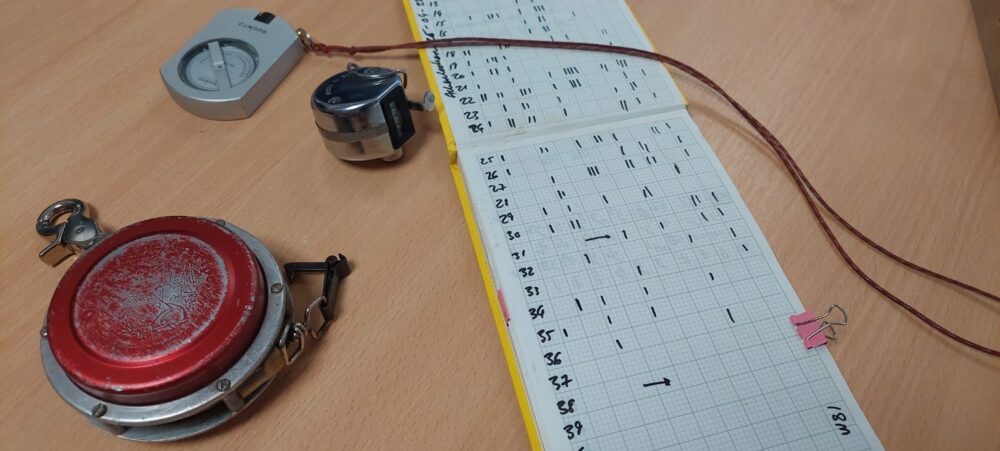What Does It All Mean?
Back in the office and I have a slightly damp notepad in front of me, with some simple lines put into boxes, which denote the size of the trees in the plots in front of me. To the untrained eye, they are incomprehensible scribbles on a page. To me, they represent valuable inventory data!
With the power of my digital map, I can input this data into my spreadsheet. What results is a final output: the information required to value the timber on the site.
What do I want to know?
There is a lot of output data. It’s all useful, but what can it be used for? The table below explains what it all means.
| Data | What does it mean? | Why do we want to know it? |
| Species | What species of trees are in the woods | Tree species vary in value. Sitka spruce is typically what the timber industry wish to purchase. Larch is equally as valuable but not demanded as much as spruce. Pine isn’t demanded very much in Argyll where this particular forest is situated. |
| Coupe Net Hectare | How big the area of trees in the sale area – with all the open ground inside the wood removed. | Most timber sale documents don’t account for the open ground on site, when referring to the hectarage of the wood. Harvesting managers buy trees, not open ground! It’s good to know the proportion of area. |
| Average Tree volume OBS | OBS – Over Bark standing
The volume of timber in each average tree on site. |
The tree size is important: we want to cut down trees that are big, but not too big. Sawmills want logs in a certain size, so selecting trees that the sawmill wants is ideal! |
| Average DBH | DBH – Diameter at breast height | Like the above, this measure is for the girth of an average tree on site and is useful to compare to the above – you want to know how big the trees are. |
| Vol/Ha | The volume of wood in the trees on a per hectare basis | This is a big one – how much wood is standing in one hectare. Generally, the higher the better! |
| Stems/Ha | The number of trees in a hectare of the wood | How dense the trees are planted. It’s a good measure of the size, as well as the ease of harvesting. |
| Total volume | The total volume of wood expected to yield from the site | This is the million-dollar figure! It’s a big determinant when bidding on a parcel of timber. |
| Average height | The average height of a tree | Good to know to estimate breakout. More on that below… |
How much therefore is it worth?
It’s not an easy question to answer. Let’s break it down a little bit…
Our main costs, at least here in Argyll, are Haulage, Contractor, and then the cost for us to supervise and market the wood. As well as this, there often miscellaneous costs, such as costs of traffic management if we are cutting trees down adjacent to a public road.
Our revenue is through the sale of the wood products harvested on the site. Sawlogs are the most valuable, then bars and pallet wood – smaller sawlogs (Sawlogs are the product which goes to the sawmill to be made into products for construction etc.) Pulpwood comes next, which is typically the smaller, skinnier tops of trees. Finally, fuelwood is the lowest value product – but still very important!
The proportions of these products cut out of the trees on site – the ‘breakout’ is crucial in valuing the wood. Too much fuelwood, or smaller logs, and the forest isn’t as valuable as one with big, straight tall trees, which would yield high-value sawlogs.
Once you have estimated yield and timber volume, you can estimate the revenue. Costs vary considerably on the site. A long distance to a sawmill will increase haulage costs, and a steep and challenging site will make the contractor require a higher price for the timber they harvest. Of course, we want a little cut too!
Finally, a price is offered to the owner of the forest. This will reflect the above economic case. Assuming the owner accepts the offer, we’ll buy the trees and manage their harvesting site for them – to a high and safe standard!
I hope this has given you a bit of an insight into the harvesting process – it’s a lot more sophisticated that it looks! I’m lucky enough to be based at the sharp end of timber harvesting in the UK. Argyll presents some challenging terrain which can be hard to overcome. I really enjoy the process of working complex sites, with the contractors and hauliers we engage.
Interested in a job in forestry or harvesting?
Take a look at the Tilhill Graduate programme




